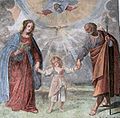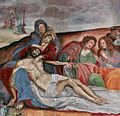Catholic Church Sagogn
The Catholic Church of the Assumption of the Virgin Mary in Sagogn in the Swiss canton of Graubünden is one of the best preserved, fully decorated church buildings of the early high baroque north of the Alps. The church stands, surrounded by a cemetery, next to the rectory from the 16th / 17th centuries. Century and the mighty bell tower on a hill south of the village part «Vitg dadens».
history
Today's church stands above various previous buildings:
- From the 5th / 6th A hall church dates back to the 18th century from the extension of the current building. It was larger than the early medieval building of the cathedral in Chur , which indicates its importance in the already densely populated Gruob .
- From the 8th / 9th A church from the Carolingian era in which the side rooms were expanded into chapels dates back to the 19th century .
- In the 12./13. In the 18th century, after a fire, a new, flat-roofed church was built over the same floor plan, with the central apse being replaced by a rectangular choir.
- The church was modernized in the 15th century, and in 1449 the mighty tower was built on the northwest corner.
- In 1664 the Capuchins , who had held parish service since 1633, began renovating the church. Among other things, the lateral apses were replaced by rectangular chapels and a vestibule was added to the north arm of the transept. It was consecrated by Bishop Johannes Flugi von Aspermont in 1640.
- In 1893 the former ossuary was reduced in size and converted into the Marienkapelle. Restorations took place in 1972 (outside) and 1987–1990 (inside).
construction
Outside
The building is determined by the components pushed together: main nave, transept, sacristy, ossuary and Marienkapelle. In 1449 the fortress-like tower was built; On its west side, the year 1449 and a maker's mark are carved three meters above the floor. The timbered bell house dates from the 16th or 17th century and is covered with a broken octagonal helmet. The crucifix dates from the end of the 17th century. The tower is made of Rasa Pietra masonry with grouting.
Inside, the richness of the furnishings in stucco and painting is striking. The ship and transverse rooms are only lit through the thermal bath windows above the three entrances.
Inside
The church is laid out in the shape of a cross. Two rectangular chapels adjoin the broad cross arms on both sides. The chorus is elevated. The original mortar cast floor dates from the construction period of 1634. The grave slab of Mont zu Löwenberg is embedded in the crossing .
The high-quality paintings are accompanied by quotations from the Bible, applied al freso and by the Italian painter Giovanni Battista Macolino (1604–1673), who also created the monumental oil painting of the naval battle of Lepanto in the Catholic Church of Pleif near Vella in Val Lumnezia in 1656 .
In addition to other images of saints, scenes from the lives of Mary, Christ, Charles Borromeo and Francis of Assisi are presented in four themed areas . The two choir shoulder altars were painted in 1757 by Placidus Schmid from Disentis / Mustér . The female figures under the gallery on the south wall of the nave from around 1400 were made by an unknown painter.
The altars date from the time the church was built around 1640, the polygonal pulpit from 1626.
literature
- Alfred Wyss, Gion Martin Pelican: Catholic parish church of the Assumption in Sagogn. (Swiss Art Guide, No. 610). Ed. Society for Swiss Art History GSK. Bern 1997, ISBN 978-3-85782-610-8 .
- Ludmila Seifert, Leza Dosch: Art guide through Graubünden: Scheidegger & Spiess, Zurich 2008; P. 172
Web links
- Catholic Church Sagogn
- Catholic parish church of the Assumption on www.graubuendenkultur.ch .
Individual evidence
Coordinates: 46 ° 47 '20.3 " N , 9 ° 15' 14.8" E ; CH1903: 738,610 / 183581








